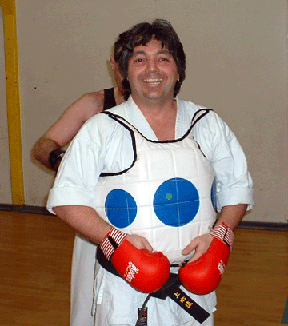Self-defense role in the Traditional Dojo
[From G.E.Mattson’s new book, “The Way of Uechi-ryu Karate” – to be published soon]
 9/11 is one of the most powerful and emotional terms in the English language. The day was burned into the memory of every American. I can only recall one other day having such impact. The day President John Kennedy was shot – a day that will forever be a bookmark in my memory. The tragedy of 9/11 affected the martial arts and spawned a whole new breed of innovators in the self defense field. The term “realism” crept into the staid and musty dojo, providing a benchmark by which everyone began to measure the effectiveness of their training.
9/11 is one of the most powerful and emotional terms in the English language. The day was burned into the memory of every American. I can only recall one other day having such impact. The day President John Kennedy was shot – a day that will forever be a bookmark in my memory. The tragedy of 9/11 affected the martial arts and spawned a whole new breed of innovators in the self defense field. The term “realism” crept into the staid and musty dojo, providing a benchmark by which everyone began to measure the effectiveness of their training.
Traditional martial arts have always survived by emphasizing the spiritual and mental benefits. Early proponents bragged that what they taught was the “ultimate” in self defense, but few were tested and few were aware of either their strengths or weaknesses.
9/11 changed all that. For some reason or other, “reality” was very much evident in our daily lives. We didn’t just read about terrorism that happened to other nations, we were now in the middle of it. Where formally we trained in lofty ideals where actual fighting didn’t exist, we now questioned our methods, our instructors and our mindset. The dojo became a place where theoretical and reality crossed paths.
One of my greatest fears during this transition was that people would abandon the traditional martial arts in favor of programs based on pure self-defense skills (Jutsu), absent of any values inherent in the traditional martial arts (Do). I believed that the old ways contained all the elements of fighting that was needed to make a person combat ready, but was hidden in the rituals of kata (one person sets) and bunkai (multiple person drills). All I had to do to retain the traditional while introducing the realistic, was to redefine the methods of interpreting the old methods.
After all, boxing went through much of the same type of evolution. It began as rigidly defined sport with rules that perpetuated the rituals while discouraging any experimentation and modifications. People will argue about whether the old-time fighters are better than the modern ones, but aside from making interesting conversation, few will really believe a Jack Dempsey would last long against many modern professional fighters. Techniques, training methods, coaching and diet all give the modern fighter an edge that cannot be overcome with ritual and tradition.
Faced with these decisions, martial art schools had to decide on an action plan. A majority of dojo, when threatened by this transition, withdrew into redefining Karate from a self-defense based training program where physical and mental were equally emphasized, into a kind of babysitting service where children were taught good manners, respect and discipline, using traditional martial art basic training. Nothing really wrong with this, except they still call what they do “Karate”! In the early years of karate, people viewed what we did as the “ultimate in self defense”, today people are being brainwashed into believing that karate is a form of baby sitting, where their kids are given “good manner” instructions unavailable and unattainable from their conventional schools.
Other dojo buried their collective heads in the sand, pretending that what they do is still the “ultimate” in self defense and that the “old” ways remain not only the best, but vastly superior to what is being offered by the eclectic “flavor of the month” self defense programs being offered by everyone who has ever been in a street fight or bounced at a local nightclub.
The schools that I believe took the most reasonable approach, simply redefined the fifty percent physical training being offered and measured its effectiveness by today’s standards of fitness and practical/realistic fighting methods.
Where in the past we practiced defensive and counter moves against primitive weapons seldom if ever used on the streets, today we acknowledge the presence of guns, knives, baseball bats and tire chains as being weapons a person might potentially encounter on the street.
Within the fifty percent “mind” part of our program, we factor in “mindset” and verbal self-defense as part of what makes up our self defense arsenal. Knowing the law concerning weapons and self-defense is also a very important part of what a traditional dojo must offer its students.
In other words, today’s traditional dojo is no longer just about punching and kicking. In other sections of this book I will touch on these subjects. Here I will describe some of the training methods that can bridge the theoretical and traditional with the realism. . . In a relatively safe manner..


